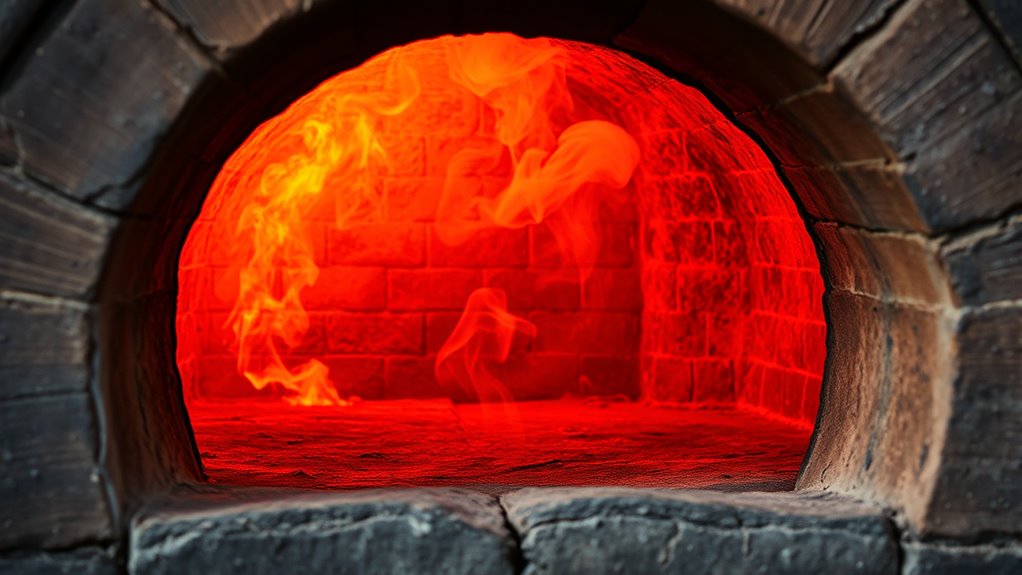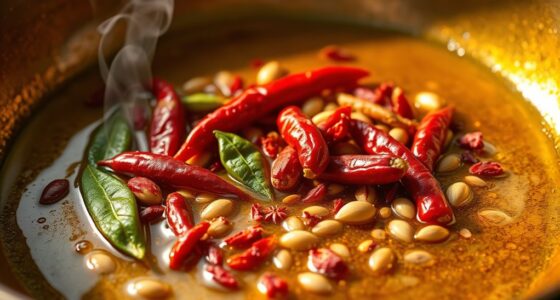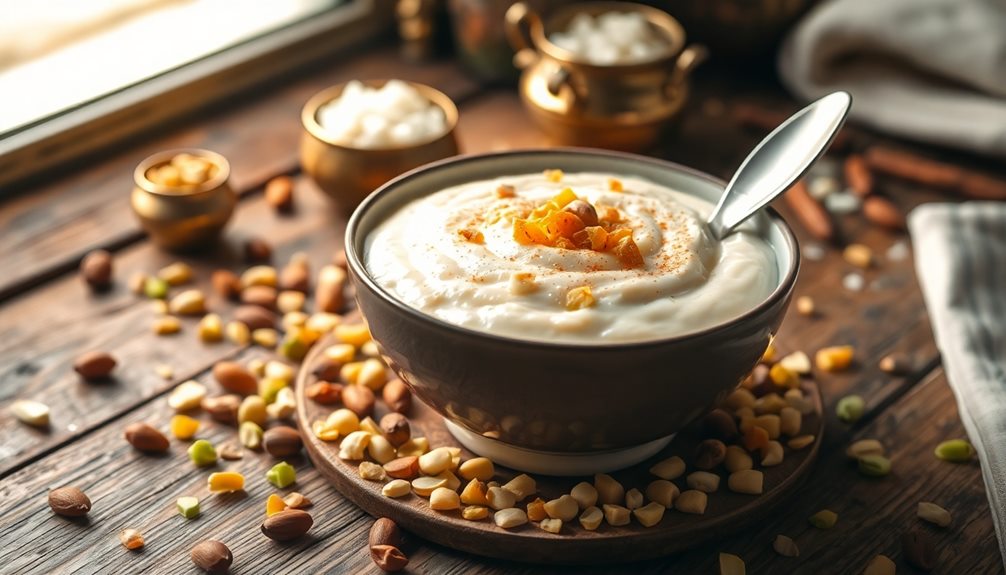In a tandoor oven, heat transfers through a mix of conduction, convection, and radiation, all working together to cook efficiently. You’ll see hot walls transfer heat directly to the food, while radiant energy from embers and walls creates surface browning and flavor. Convection currents circulate hot air to guarantee even cooking, preventing cold spots. Understanding these combined heat transfer mechanisms helps you grasp how tandoors produce their signature quick, uniform, and flavorful dishes; exploring further reveals the fascinating science behind it.
Key Takeaways
- Tandoor ovens utilize conduction, convection, and radiation synergistically for efficient heat transfer.
- Hot clay or brick walls conduct heat directly to food, ensuring even cooking and crust formation.
- Radiant heat from embers and walls provides rapid surface browning and flavor development.
- Convection currents circulate hot air, promoting uniform temperature distribution inside the oven.
- The integration of these mechanisms enables quick, consistent, and characteristic tandoor cooking results.

Tandoor ovens efficiently transfer heat through a combination of conduction, convection, and radiation, enabling them to cook food quickly and evenly. As you operate or study these traditional cooking devices, understanding how each mode contributes becomes essential. Thermal conduction plays a crucial role because it involves direct heat transfer from the hot interior walls of the tandoor to the food. When the oven’s heated clay or brick walls reach high temperatures, heat moves through these materials by conduction, directly warming the food resting against or near the surface. This process ensures that ingredients like bread or skewered meats receive consistent and thorough heat at their contact points, resulting in a well-cooked interior and a desirable crust.
Tandoor ovens use conduction, convection, and radiation for quick, even cooking.
Radiant heat, on the other hand, radiates from the oven’s hot walls and embers, traveling through the air inside the tandoor and striking the food surface directly. You’ll notice that the intense radiant heat from the heated clay walls creates a distinctive char or crispiness on the exterior of dishes like naan or kebabs. This radiant energy transfers energy in the form of electromagnetic waves, which means the heat can reach the food even without direct contact. The combination of thermal conduction and radiant heat ensures a rapid and evenly distributed cooking process, giving the food the characteristic textures and flavors associated with tandoor cooking. Additionally, understanding the heat transfer mechanisms involved can help in troubleshooting and optimizing cooking times and results. Recognizing the importance of material properties like thermal conductivity can further enhance your control over the cooking process. Moreover, the temperature distribution within the oven influences the overall cooking efficiency and quality of the final dish.
Convection also contributes considerably, especially as hot air circulates within the tandoor chamber. The circulation occurs naturally, as hot air rises and cooler air sinks, creating a convection current. This movement distributes heat uniformly around the food, preventing hot spots and ensuring even cooking. You might observe that the convection process helps maintain a stable temperature inside the oven, making it easier to cook multiple items simultaneously with consistent results. Recognizing the role of air circulation can further enhance your control over the cooking process.
Together, these three heat transfer mechanisms work in harmony, making the tandoor an efficient cooking vessel. The high thermal conductivity of the clay walls ensures rapid heat transfer through conduction, while radiant heat from the embers and walls adds intense surface heating. Meanwhile, convection maintains a uniform temperature environment inside the oven, supporting even cooking. When you understand how these processes operate collectively, you can better appreciate the craftsmanship behind tandoor cooking and optimize your techniques for perfect results. Whether you’re a chef, a home cook, or simply an enthusiast, recognizing the interplay of thermal conduction and radiant heat helps you control and harness the unique heat transfer properties of a tandoor oven.
Frequently Asked Questions
How Does the Type of Fuel Affect Heat Transfer Efficiency?
When considering how the type of fuel affects heat transfer efficiency, you should look at fuel combustion. Different fuels burn at varying rates and temperatures, influencing how much heat is produced. This heat conducts through the oven walls, affecting overall efficiency. Choosing a fuel with complete combustion and high heat output ensures better heat conduction, resulting in faster cooking times and energy savings.
What Materials Optimize Heat Retention in Tandoor Construction?
Imagine a tandoor as a warm hug; the right materials keep that warmth close. You’ll want ceramic composition with high thermal mass, like dense clay or brick, to absorb and retain heat efficiently. These materials act like a sponge, holding onto heat longer and evenly distributing it, which is essential for consistent cooking. Using such materials guarantees your tandoor stays hot, saving energy and improving the flavor of your dishes.
How Does Ambient Temperature Influence Tandoor Heating Performance?
Ambient temperature effects your tandoor’s heating performance by influencing how quickly it reaches and maintains the desired temperature. When the surrounding air is warmer, your tandoor may heat more efficiently, aiding thermal regulation. Conversely, colder ambient temperatures can slow down heating and make it harder to sustain consistent heat. Understanding these effects helps you better manage your tandoor, ensuring ideal cooking results regardless of external conditions.
Can Insulation Improve Heat Transfer Control in Tandoor Ovens?
Oh, sure, insulation must be the magic trick to control heat transfer in tandoors—because who wouldn’t want to turn their fiery oven into a cozy cabin? Insulation effectiveness minimizes heat loss, ensuring the oven stays hot and efficient. By preventing heat from escaping, you get better temperature control, faster cooking, and less fuel wasted. It’s like giving your tandoor a warm, insulating blanket—who knew heat transfer could be so delightful?
What Safety Measures Are Essential During Tandoor Operation?
During tandoor operation, you must prioritize fire safety and personal protection. Always keep a fire extinguisher nearby and ensure proper ventilation to prevent buildup of dangerous gases. Wear heat-resistant gloves, long sleeves, and eye protection to avoid burns. Regularly inspect the oven for cracks or leaks, and never leave it unattended while in use. These safety measures help prevent accidents and keep you protected during the cooking process.
Conclusion
As you consider the heat transfer in tandoor ovens, you see how traditional methods meet modern science. While the intense, radiant heat cooks your bread perfectly, the simple clay walls insulate and conserve warmth. It’s a delicate balance between fiery energy and gentle containment. You realize that understanding this dance of heat not only improves cooking but also honors centuries of craftsmanship—where fire’s brutality and clay’s softness coexist in harmony, creating culinary art.










